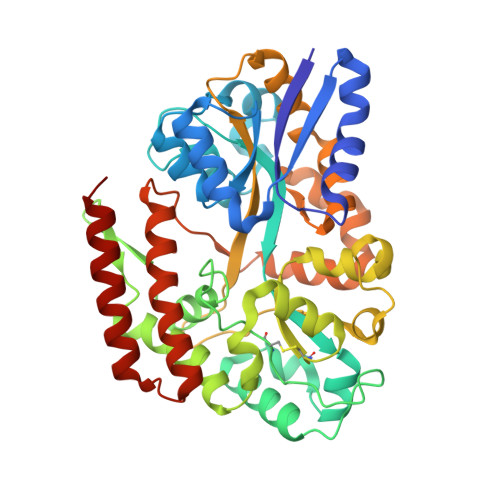Conformational Trapping of a beta-Glucosides-Binding Protein Unveils the Selective Two-Step Ligand-Binding Mechanism of ABC Importers.
Chandravanshi, M., Samanta, R., Kanaujia, S.P.(2020) J Mol Biology 432: 5711-5734
- PubMed: 32866452
- DOI: https://doi.org/10.1016/j.jmb.2020.08.021
- Primary Citation of Related Structures:
7C63, 7C64, 7C66, 7C67, 7C68, 7C69, 7C6F, 7C6G, 7C6H, 7C6I, 7C6J, 7C6K, 7C6L, 7C6M, 7C6N, 7C6R, 7C6T, 7C6V, 7C6W, 7C6X, 7C6Y, 7C6Z, 7C70, 7C71 - PubMed Abstract:
Substrate-binding proteins (SBPs), selectively capture ligand(s) and ensure their translocation via its cognate ATP-binding cassette (ABC) import system. SBPs bind their cognate ligand(s) via an induced-fit mechanism known as the "Venus Fly-trap"; however, this mechanism lacks the atomic details of all conformational landscape as the confirmatory evidence(s) in its support. In this study, we delineate the atomic details of an SBP, ¦Â-glucosides-binding protein (¦ÂGlyBP) from Thermus thermophilus HB8. The protein ¦ÂGlyBP is multi-specific and binds to different types of ¦Â-glucosides varying in their glycosidic linkages viz. ¦Â-1,2; ¦Â-1,3; ¦Â-1,4 and ¦Â-1,6 with a degree of polymerization of 2-5 glucosyl units. Structurally, the protein ¦ÂGlyBP possesses four subdomains (N1, N2, C1 and C2). The unliganded protein ¦ÂGlyBP remains in an open state, which closes upon binding to sophorose (SOP2), laminari-oligosaccharides (LAMn), cello-oligosaccharides (CELn), and gentiobiose (GEN2). This study reports, for the first time, four different structural states (open-unliganded, partial-open-unliganded, open-liganded and closed-liganded) of the protein ¦ÂGlyBP, revealing its conformational changes upon ligand binding and suggesting a two-step induced-fit mechanism. Further, results suggest that the conformational changes of N1 and C1 subdomains drive the ligand binding, unlike that of the whole N- and C-terminal domains (NTD and CTD) as known in the "Venus Fly-trap" mechanism. Additionally, profiling of stereo-selection mechanism for ¦Á- and ¦Â-glucosides reveals that in the ligand-binding site four secondary structural elements (L1, H1, H2 and H3) drive the ligand selection. In summary, results demonstrate that the details of conformational changes and ligand selection are pre-encoded in the SBPs.
Organizational Affiliation:
Department of Biosciences and Bioengineering, Indian Institute of Technology Guwahati, Guwahati 781039, Assam, India.






















